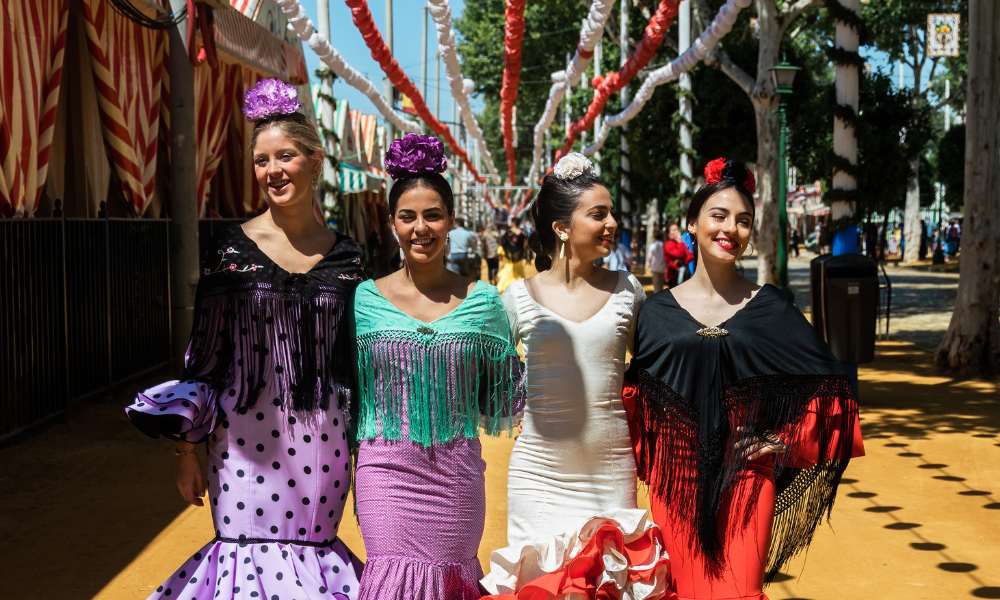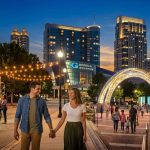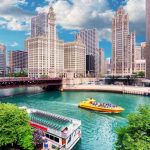Spain is a country that lives and breathes Spanish cultural celebrations, drawing visitors from every corner of the globe. With its history, flair, and unforgettable energy, unique festivals in Spain are an essential part of the experience. With massive street parties to traditional parades, these events celebrate the very essence of Spanish culture. If it’s the music, dance, or the irresistible food, Spanish fiesta traditions are a must-see.
If you’re eager to dip yourself in Spanish heritage events, why not go all in? There are 5 incredible traditional festivals in Spain you absolutely can’t miss. These festivals offer a perfect blend of local traditions, lively celebrations, and a chance to experience Spain’s heart and soul.
Planning your trip to Spain during festivals? From luxury vacation rentals to cozy hotels, you’ll find plenty of options to make your stay as seamless as your festival adventure. So buckle up—this journey through Spain’s most iconic festivals will leave you with unforgettable memories and a deeper connection to the Spanish spirit. Ready for the journey? Let’s dive in!
Table of Content
Famous festivals in Spain
Spain is renowned for its lively and diverse festivals that reflect the country’s rich cultural heritage. For those eager to dive into Spanish fiesta traditions, these festivals are essential for experiencing Spain’s lively spirit and unique customs. Here are 5 most famous festivals in Spain that we’ll cover today –
- El Colacho Baby-Jumping
- San Juan Bonfire
- Rapa das Bestas
- San Fermín
- Feria de Abril
1. El Colacho Baby-Jumping Festival in Castrillo de Murcia
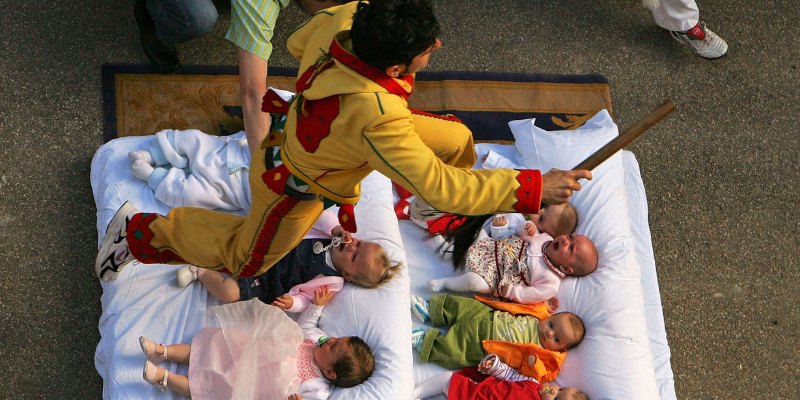
When: June (Corpus Christi celebration)
Where: Castrillo de Murcia, near Burgos
Famous For: El Colacho baby-jumping festival is one of the most unique cultural experiences in Spain, where costumed “devils” leap over rows of babies to ward off evil spirits.
Highlights: Traditional costumes, religious rites, and a blend of Spanish folklore and festivals create an experience that feels almost surreal. This event, part of religious festivals in Spain, is celebrated with much enthusiasm, drawing locals and tourists alike.
The El Colacho Baby-Jumping Festival, held in Castrillo de Murcia, Spain, is one of the world’s most unique and visually striking traditions. Each year, this small village in northern Spain celebrates Corpus Christi in a way that is both daring and symbolic: by having grown men dressed as devils, or El Colacho, leap over rows of babies lying on mattresses in the street.
This tradition, dating back to the early 17th century, is believed to cleanse infants of original sin, protect them from evil spirits, and ensure their safe passage through life. While it might look risky, locals maintain strict safety measures to ensure that the babies are unharmed. El Colacho has been recognized by Spanish cultural organizations as a unique expression of regional heritage, and in recent years, it has attracted attention from around the world for its fascinating blend of folklore, faith, and spectacle.
2. San Juan Bonfire Festival in Alicante
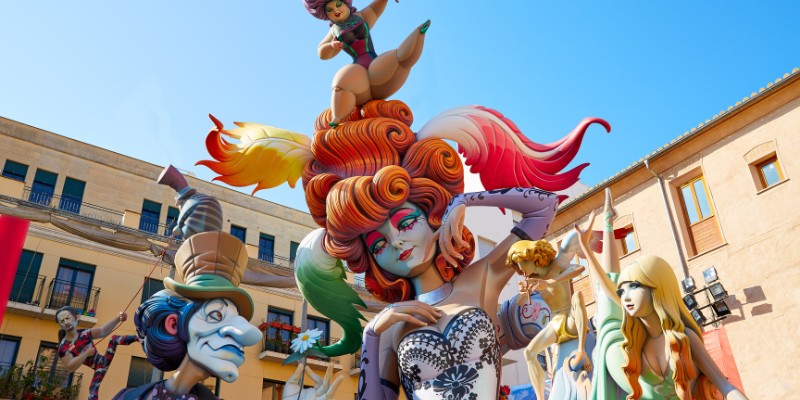
When: June 23rd
Where: Alicante, but celebrated across Spain
Famous For: The San Juan Bonfire Festival is a popular holiday in Spain marking the summer solstice with massive bonfires and fireworks on the beach.
Highlights: With people gathering around bonfires, fireworks lighting up the night, and beach parties running until dawn, this is the ultimate Spanish summer festival experience. It’s not only an exciting festival in Spain but also a way to celebrate Spain’s seasonal celebrations under the stars.
The San Juan Bonfire Festival (Hogueras de San Juan) in Alicante, Spain, is a vibrant and fiery celebration that ushers in the summer solstice with a bang! This lively festival takes place annually in late June, culminating on the night of June 24th. It combines music, fireworks, elaborate sculptures, and a thrilling atmosphere that takes over the city streets, making it one of Spain’s most exciting fiestas.
The festival’s highlight is the creation of towering, intricate sculptures called hogueras (bonfires), made from wood, cardboard, and other combustible materials. This is a unique blend of art, tradition, and celebration, offering a perfect way to experience Alicante’s rich cultural heritage and community pride. It’s a must-see for anyone looking to experience Spain’s festival culture at its finest!
3. Rapa das Bestas Festival in Galicia
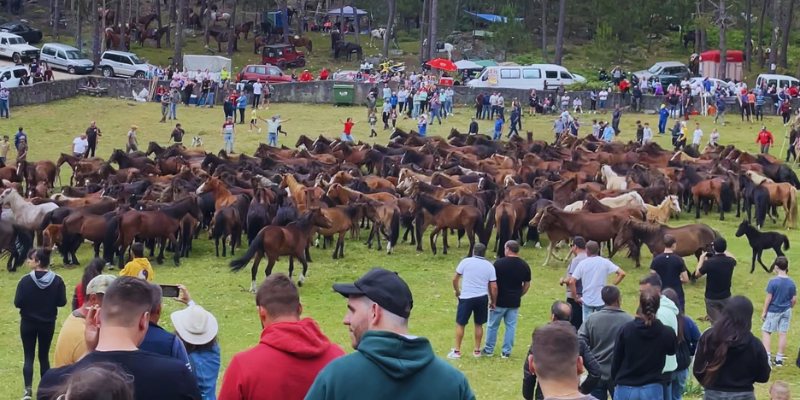
When: First weekend of July
Where: Sabucedo, Galicia
Famous For: Known for the traditional herding of wild horses, Rapa das Bestas is one of the most iconic events in Spain. This festival is a powerful representation of Spanish folklore and festivals as the locals bring in wild horses from the mountains to cut their manes.
Highlights: Expect to see traditional music, dance, and courage displayed in the Spanish festival activities that celebrate human connection with nature.
The Rapa das Bestas (Shearing of the Beasts) is a centuries-old, adrenaline-filled festival celebrated in Galicia, Spain, where participants round up and tame wild horses from the mountains. Taking place in several villages throughout Galicia—most famously in Sabucedo near Pontevedra—this festival typically occurs in early July. It’s a spectacular display of strength, tradition, and a deep-rooted connection between the locals and the wild horses that roam the Galician countryside.
The festival begins with the curro, where villagers and aloitadores (specialized wrestlers) gather to herd the horses down from the hills into enclosed arenas. Once the horses are gathered, the aloitadores wrestle them, without ropes or tools, to trim their manes and tails and mark the animals. The wrestlers rely on skill, agility, and a unique bond with the horses to control them without causing harm. For the locals, this is a test of endurance and a point of pride, as they engage with the raw power and untamed spirit of the horses.
With its blend of human and animal interaction, Rapa das Bestas offers a thrilling experience and an authentic glimpse into Galician heritage. The festival is as much a celebration of bravery and skill as it is a tribute to the timeless relationship between humans and nature in rural Spain.
4. San Fermín Festival in Pamplona
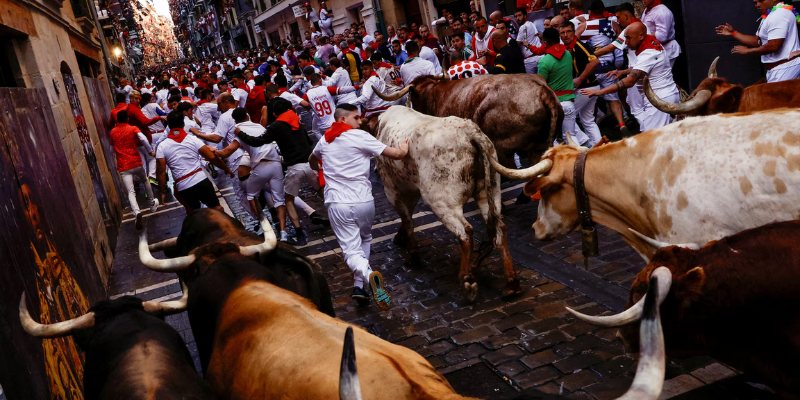
When: July 6th – 14th
Where: Pamplona
Famous For: The San Fermín Festival is perhaps the most famous Spanish carnival and parade due to the Running of the Bulls, where participants race alongside bulls through the city’s streets.
Highlights: Celebrated with parades, fireworks, and traditional music, this is one of the most famous Spanish festivals for travelers. It’s an annual Spanish tradition that combines excitement and tradition, making it an unforgettable experience.
The San Fermín Festival, held annually in Pamplona, Spain, is one of the world’s most famous and exhilarating festivals. Known primarily for the encierro, or the Running of the Bulls, this festival transforms the city into a non-stop celebration of culture, tradition, and thrill-seeking, attracting locals and visitors alike from July 6th to July 14th.
The festivities begin on July 6th at noon, when thousands gather in the city’s main square to witness the chupinazo, a rocket launch marking the official start of San Fermín. The streets fill with revelers dressed in traditional white outfits with red scarves, symbolizing the colors of San Fermín, the patron saint of Navarra, after whom the festival is named.
The San Fermín Festival has a rich history, dating back to the Middle Ages, and gained global fame largely due to Ernest Hemingway’s novel The Sun Also Rises. It’s a fascinating blend of heritage and celebration that showcases Spain’s passion, bravery, and community spirit.
5. Feria de Abril in Seville
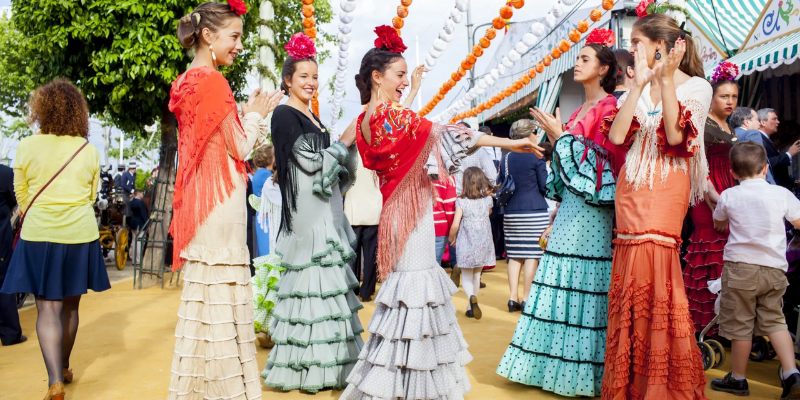
When: Two weeks after Easter
Where: Seville
Famous For: Known for its Spanish flamenco festivals and lavish traditional costumes at Spanish festivals, Feria de Abril showcases the best of Andalusian culture.
Highlights: Flamenco performances, traditional dance, and Spain’s food festivals fill the streets with the sights, sounds, and tastes of Seville. This festival calendar in Spain classic is perfect for soaking in Spanish festival traditions.
The Feria de Abril (April Fair) in Seville is one of Spain’s most vibrant and colorful festivals, held every spring, typically two weeks after Easter. This week-long celebration, which usually takes place in April, marks the arrival of warmer weather with a blend of flamenco, bullfighting, music, and traditional Andalusian culture.
Music is at the heart of the Feria de Abril, with flamenco performances echoing through the tents, and people dancing the sevillanas, a regional folk dance. The rhythm of the sevillanas creates an electric atmosphere as both locals and visitors join in the spirited dancing, making it a key feature of the festival.
The Feria de Abril is a true celebration of Seville’s cultural identity, full of joy, color, and passion. For anyone visiting Seville in the spring, it’s a must-see event that captures the essence of Andalusian life and tradition.
Things to Do at Spanish Festivals
Attending festivals in Spain isn’t just about being a spectator – it’s about diving into the traditional events in Spain and getting involved in the celebrations. Here’s a quick guide to things to do at these vibrant events –
- Watch Parades: Enjoy colorful parades with music, costumes, and dancers at Feria de Abril in Seville.
- Join the Dance: Participate in traditional dances with locals at music festivals in Spain or try traditional Spanish dances.
- Try Local Cuisine: Sample local cuisine at Spain’s food festivals, which often include delicacies specific to each region.
- Wear Traditional Costumes: Dress up! Many festivals encourage attendees to wear traditional outfits or themed costumes, especially at historic festivals in Spain.
- Take Photographs: Photograph the scenes for an unforgettable memory – best festivals to attend in Spain offer colorful backdrops perfect for photography.
- Stay in Comfort: Vacation rentals in Spain offer the perfect blend of flexibility and relaxation. These inviting spaces are ideal for couples or solo travelers seeking the freedom to enjoy festivals and unwind in a beautiful, picturesque setting.
Conclusion
Spain’s famous festivals offer a rich tapestry of culture, tradition, and excitement, making them a must-see for anyone eager to experience the heart and soul of the country. Spain’s annual festivals are an unmissable part of any travel adventure, offering unforgettable experiences that will stay with you long after the celebrations end. For those looking for a deeper connection to the local culture, gaining local insights on Spanish festivals will enhance your appreciation of these vibrant events and give you a genuine understanding of Spain’s rich traditions. So don’t delay, pack your bag and dive into Spain’s festive.
FAQs
The San Fermín Festival in Pamplona, known for the Running of the Bulls, is one of the most famous festivals worldwide.
The Running of the Bulls and Spanish flamenco festivals are iconic traditions in Spain.
The San Fermín Festival is globally renowned, drawing thousands of visitors each year.
Día de la Hispanidad (Hispanic Day) on October 12th is considered a national festivity in Spain.
Spain has hundreds of festivals yearly, with each region boasting its Spanish seasonal celebrations.
The Las Fallas festival in Valencia and San Fermín are among the biggest festivals in Spain.
Spanish festivals are known as fiestas, where the celebration of Spanish fiesta traditions brings communities together.
The Feria de Abril in Seville is one of the most famous and colorful celebrations in Spain.
Spain’s festivals are popular due to their cultural richness, community involvement, and joyous atmosphere that embody Spain’s vibrant festival traditions.
Spain has around 14 national holidays annually, alongside numerous local and regional annual Spanish traditions celebrated as public holidays.
More Related Blogs From Travel Recommendations
What Are the Safest Things to do in Atlanta at Night for Tourists?
Full List of Things to Do in Toronto: Simple, Stress-Free Picks!
Best Restaurants in Toronto 2025-26: Where to Eat by Budget & Mood
Best Restaurants in Vancouver Worth Every Bite, Dollar & Hype!
Mark Smith
Introducing Mark Smith, a wanderlust-fueled travel author on a mission to inspire others to embrace exploration and discovery. From the colorful markets of Marrakech to the tranquil rice paddies of Ubud, Mark Smith’s vibrant narratives capture the essence of each destination, weaving tales of culture, cuisine, and unforgettable experiences. Join Mark Smith on his quest to uncover the beauty of our world, one adventure at a time.
